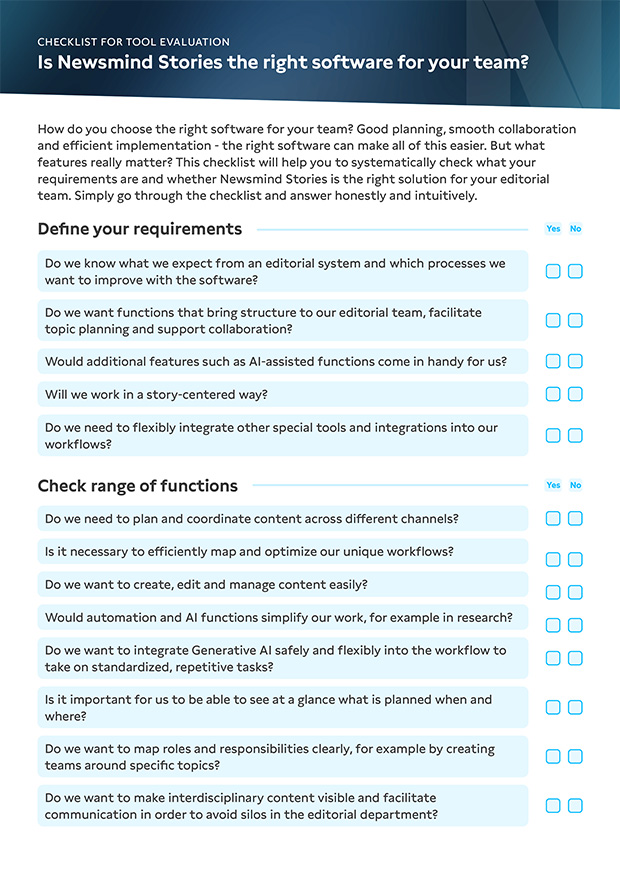In newsrooms and editorial teams, holistic exchange and story-centered editorial planning are important. The concept of the newsroom – whether in journalistic editorial offices or companies – has therefore become established. It is where all content and communication measures come together: A central place to discuss, plan and implement topics. This noticeably increases the efficiency of editorial teams. Yet with more and more sources of information, channels and content, many teams are reaching the limits of their topic planning. Manually planning, keeping silos or working with Excel sheets or Trello are no longer efficient enough. That is why the role of tech platforms in news and corporate departments, like newsroom computer systems, becomes more and more important. Media organizations need newsroom software to cope with the flood of information and channels. It helps journalists and marketers to automate research and monitoring tasks and to simplify content production and distribution. You don’t know if newsroom software is the tool your are looking for? Don’t worry: You’ll find everything you need to know about newsroom computer systems on this page.
Content of this page
What is newsroom software?
Newsroom planning software helps content teams and editorial teams to plan content for multiple platforms and efficiently manage the entire editorial process – from topic research and topic planning to the preparation and production of content in the form of text, video and audio files and their publication on various channels. With the right newsroom computer system, content production can therefore be better organized both strategically and operationally.
The result: Media organizations are able to prepare content more efficiently and in a way that it can be distributed across different channels and touchpoints. This means that newsroom software is indispensable for successful integrated communication and cross-media production, as is required in media houses but also in the corporate newsroom.

And who benefits from newsroom software?
Even though the traditional newsroom was first established in journalism newsrooms, newsroom software is not only intended for newsroom staff, but also for editorial teams and content departments in general. After all, every company today is actually a content powerhouse that has the complex task of navigating between content planning, media assets and the many channels. So, newsroom systems are made for any team that wants to manage content workflows more efficiently:
- News Desks
- Editorial Offices
- Corporate Newsrooms
- PR Departments
- Marketing Teams
- Publishers and Broadcasters
Whether editorial offices in media companies or corporate communications planning: newsroom software is made for any team that wants to manage content workflows more efficiently and wants a better overview. That said, not all software is the same: different newsroom platforms certainly have different functions. Here, teams need to take a close look at what requirements they have or what tasks they need to accomplish.
Why is that useful to newsroom management?
News agencies, research networks, press representatives, event platforms, public authorities, personal contacts, the research of your own editors, social media posts – there are many sources of information. And the number is growing all the time. Newsroom staff – whether in media groups, national dailies, local weeklies, agencies or companies – all face the same challenge: They have to
- maintain an overview in the dense information jungle and
- include those topics in their editorial planning that are relevant to their intended target group.
- Moreover, they have to process the topics efficiently and publish them cross-media.
But how exactly does newsroom software help? How does a computer system for journalists and content teams work?
Modern newsroom software can support all planning levels of media production: Research and planning, production and publication. The ultimate goal is to turn ideas into publications quickly and efficiently – and consistently across all channels.
That’s why newsroom software is ideally strong at monitoring countless streams, pre-sorting incoming messages and summarizing them in topic clusters. In addition, it should also support creation and distribution by providing a clear digital “single source of truth” for all employees: Content is available centrally and collaboration is simplified.
How does newsroom software simplify topic planning?
Let’s take a closer look at how it supports research and topic planning: A good newsroom software can do the work for you by automating the monitoring of sources. It makes no difference whether the source of information is a news ticker, the website of a media company or Instagram feeds. News is received in real time and if the newsroom planning software is supported by AI, it can also automatically calculate the proximity between topics and thus display similar messages – clearly sorted – in a dashboard. Employees in the digital newsroom benefit from this in several ways. They can They can
- get an overview of the current topics and news situation very quickly and create a targeted editorial plan.
- search through various topic clusters in a systematic manner and tag relevant news stories.
- decide, as the situation demands, which topics and aspects they consider relevant for later articles or video contributions.
- add tweets or other multimedia content from the archive to their collection of topics.
- add agency and press releases as well as social media posts to their topic collection.
- link all objects within the topic collection with each other and in this way reflect the complex world events in the editorial topic planning adequately.
- plan articles cross-medially for all channels and platforms connected to the tool.
- create and implement media-specific editorial articles based on the topic list.
- use integrators to process articles on social media platforms and internal production systems to publish them in the desired publication medium.
What are the advantages of innovative newsroom computer systems?
Find, plan and develop topics more easily: A newsroom tool therefore simplifies the daily work of employees in the newsroom and increases the efficiency of the entire editorial team, particularly in these three areas:

Collaboration
Newsroom software enables true collaboration. The newsroom tool bundles all information centrally, provides an overview of the status and transparently displays which colleagues are working on a topic in which way, and who is planning to publish which topic in which format in which channel. This is particularly beneficial for large media companies and corporate newsrooms. They can make better use of the resources of their employees: either they work together on a multi-layered topic, or different aspects of a complex topic are examined from different perspectives.
Monitoring
Newsroom management software makes it possible to monitor numerous sources in real time: whether it is news agency reports, X (Twitter) channels or even the contributions of competitors. Using feeds and personalized dashboards, employees can quickly see which trends are emerging and which topics are relevant to them. This allows editors to consciously set their articles apart from the competition, to take a different angle or to pick up on an aspect and expand on it. It is also essential for effective SEO measures to know the publications of the competition in order to successively improve one’s own ranking in organic hit lists.


Distribution
Newsroom planning software is not only made for planning, but should also take distribution into account: either by exporting content to existing distribution systems, directly via integration of social media platforms or via interfaces to special tools. This allows teams to publish their content quickly and with just a few clicks on the appropriate channels – without tool chaos. As a result, they save a lot of time by avoiding copy-paste processes or inconsistent communication.
Is Newsmind Stories the right software for your team?
Our checklist will help you to check what your requirements are and whether Newsmind Stories is the right solution for your team.

Which software for news channels and content production is best?
The right newsroom software always depends on the individual newsroom or company. For PR and corporate communications, there are already some well-known newsroom tools that may focus on just individual channels. The emphasis here may be on integration with the CMS, i.e. the website, or press monitoring with the integration of news agency reports.
However, media companies with many different formats and many channels to be covered need software that is ideally suited to more complex journalistic processes and multichannel publishing – for example, Newsmind Stories. Such newsroom systems are designed to integrate many sources and channels and to develop, coordinate and cross-media publish content step by step.
So which category should it be? These questions can help you make an initial selection, making it easier to compare newsroom software:
- Which tasks should the software support? Am I looking for a tool that works as a website CMS or organizes our content processes cross-media?
- Which channels do I want to integrate?
- Which sources do I need to monitor?
- How many editors need to work with the software?
- Can I adapt my workflows or should the tool adapt to us?
- Do I also need integrated digital asset management for media such as images and videos or archive material for content creation?
- Should the newsroom be in the cloud so I can work location-independently?
- What kind of support do I want from the provider?
Only when the basic category questions have been clarified can the various newsroom system providers be compared with each other.
Want to find out more about the newsroom software Newsmind Stories?
Schedule a personal talk with us – for free and no strings attached.
What is important to consider when choosing newsroom software?
When editorial departments decide on a newsdesk software, it is advisable to also have aspects in mind that go beyond pure functionality:
Integrable
In times of Big Data, it is crucial to use all available data. That’s why it should be possible to connect any number of data sources to the newsroom software.
Built for teamwork
Collaboration should be encouraged. Let editorial teams come together digitally to discuss, plan and implement stories. Look for a story-centric approach and features such as integrated chat functionality and collaborative editing so that employees can easily interact in the newsroom.
Built to be customizable
Needs of newsrooms and teams are changing all the time: Editors and managers need workflows and individual views that they can customize and create to suit their personal preferences. Since every newsroom works differently, newsroom software must allow flexibility and adapt to existing processes – and not the other way around.
Built to be clear
A modern, intuitive user interface (UI) ensures that users do not lose track of all the information and enjoy working with the newsroom tool (good user experience, UX).
Beispiel: Newsroom Tools mit KI
What features further simplify the work in the newsroom and create a productive, efficient editorial environment? Technological advances are constantly allowing editorial teams to be supported in a meaningful way. One example: The newsroom computer systems Newsmind Stories goes one step further than conventional editorial systems. It integrates artificial intelligence directly into the editorial workflow to accelerate and automate media production. Automated processes and generative AI therefore support monitoring and research as well as the creation of articles, social media posts and publications. Some examples, how AI supports media here:
- The AI automatically monitors linked sources and pre-sorts relevant news and topics according to relevance.
- The AI also finds publications from internal sources that match the editors’ plans. This gives a complete overview and avoids unnecessary duplication of work.
- With just one click, users can generate articles, social media posts or even moderation texts and use them as drafts or publish them directly.
- A text-to-speech feature allows a human-like audio track to be generated directly from a text for presentations, planning or social media.
Online Newsroom Example – Software in practice
The German public broadcaster Westdeutscher Rundfunk is successfully using a newsroom software solution. Thanks to Plan.R, which is based on Newsmind Stories, WDR employees benefit from the advantages of cross-media editorial planning and story-centric news production as well as the timely distribution of articles in the respective medium.
Success Story
Get the WDR story sent to you now:
Newsroom software – our conclusion
A newsroom that wants to communicate in an efficient, integrated and cross-media manner cannot do without an AI-based newsroom computer system. Such a newsroom software enables editorial staff to centrally bundle any information sources, to summarize content-related information and to easily and quickly plan and publish all kinds of articles – from texts to videos and audios to social media posts. This makes newsroom software an indispensable tool in a competitive newsroom.
More interesting articles that you shouldn’t miss





